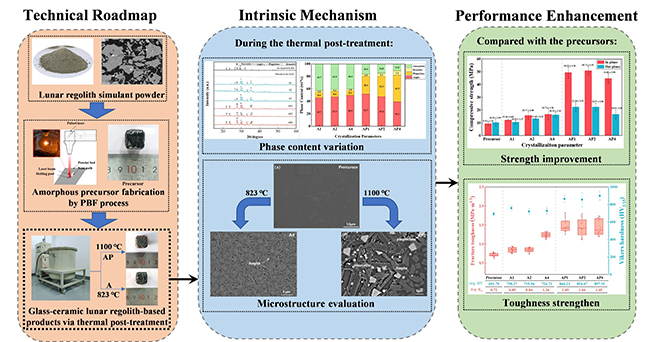Significance
The pursuit of establishing a sustainable human presence on the Moon requires innovative approaches in producing reliable in-situ engineering materials that are independent of terrestrial supplements. Lunar regolith-based glass-ceramics are materials made by processing the lunar soil, known as regolith, into glass and then further into ceramics using various manufacturing methods. These materials are of significant interest for lunar exploration due to their potential for use in building materials, and manufacturing of various technologies directly on the Moon which reduces the need for expensive transport of materials from Earth. Lunar regolith is a layer of fine dust and broken rock that covers the Moon’s surface and composed of various minerals and glass particles formed by meteorite impacts. The regolith can be collected and processed to create glass-ceramics by melting the regolith, cooling it to form glass, and then partially crystallizing the glass to produce a material that has the toughness of glass and the hardness of ceramics. The advantage of using lunar regolith-based glass-ceramics includes the abundance of raw materials on the Moon, which makes it a sustainable and cost-effective option for construction and manufacturing in lunar bases. Developing technologies to efficiently create lunar regolith-based glass-ceramics is an area of extensive research. Scientists and engineers are exploring different methods to process the regolith, optimize the material properties for various uses, and develop techniques that could be feasibly implemented on the Moon using lunar resources and energy sources. To this account, a new study published in Construction and Building Materials and conducted by PhD candidate Rui Wang, Professor Guofu Qiao, and Associate Professor Guangping Song from the Harbin Institute of Technology, the authors conducted comprehensive study focuses on leveraging powder bed fusion, a subset of additive manufacturing techniques, for in-situ resource utilization (ISRU) in lunar missions. This new approach is particularly appealing due to the challenges associated with the lunar environment, such as limited energy supply, equipment operational difficulties, and material amorphization from rapid thermal cycles. They explored the use of laser powder bed fusion (LPBF) with specific parameters to manufacture glass-ceramic products from lunar regolith simulant (LRS).
Initially, the researchers identified optimal LPBF parameters by experimenting with large laser spot sizes and low scan speeds to print glassy precursors from LRS. They established an acceptable range of volumetric energy density (VED) essential for the formation of high-quality lunar regolith-based components, setting the stage for subsequent thermal treatment. Following LPBF, the glassy precursors underwent thermal treatment at varying temperatures to induce crystallization, transforming them into glass–ceramic materials. The team experimented with different thermal profiles to determine the impact on the microstructural evolution and phase formation of the materials. They subjected both the precursors and the resulting glass-ceramic products to extensive characterization and examined their microstructure through scanning electron microscopy and polarized light microscopy, analyzing phase compositions via X-ray diffraction, and assessing mechanical properties including compressive strength, fracture toughness, and Vickers hardness. Thermophysical properties, such as thermal conductivity, were also evaluated to gauge the materials’ suitability for lunar construction. The researchers determined that a VED range of 3.5 to 4.3 J/mm³ was optimal for producing lunar regolith components with the LPBF technique. This range was crucial for achieving a balance between energy efficiency and the quality of the printed parts. They found the thermal post-treatment significantly influenced the microstructural evolution of the glass-ceramic materials. At 823°C, augite phase-dominated glass-ceramics were formed, whereas at 1100°C, a transition to augite-plagioclase polycrystalline glass-ceramics occurred, indicating phase diversification with increased treatment temperature. Moreover, the mechanical properties of the glass-ceramic products improved markedly with thermal post-treatment. Notably, the materials treated at 1100°C exhibited superior compressive strength, fracture toughness, and Vickers hardness, demonstrating the effectiveness of the multi-process approach in enhancing material performance. Despite the presence of porosity, primarily due to the LPBF process’s nature, the materials maintained low thermal conductivities, suggesting potential for thermal insulation applications in lunar habitats. This characteristic, combined with acceptable mechanical strength, underscores the materials’ suitability for constructing lunar infrastructure.
In conclusion, the detailed investigation by Wang, Qiao, and Song has elucidated a viable pathway for utilizing lunar regolith in the creation of building materials for future lunar missions. They have successfully developed glass-ceramic materials with promising properties for in-situ construction on the Moon by their innovative approach optimizing LPBF parameters and employing targeted thermal post-treatments. Their findings advance our understanding of lunar regolith-based additive manufacturing and highlight the potential for significant contributions to the sustainability of future lunar habitats.

Reference
Rui Wang, Guofu Qiao, Guangping Song, Additive manufacturing by laser powder bed fusion and thermal post-treatment of the lunar-regolith-based glass-ceramics for in-situ resource utilization, Construction and Building Materials, Volume 392, 2023, 132051,
 Advances in Engineering Advances in Engineering features breaking research judged by Advances in Engineering advisory team to be of key importance in the Engineering field. Papers are selected from over 10,000 published each week from most peer reviewed journals.
Advances in Engineering Advances in Engineering features breaking research judged by Advances in Engineering advisory team to be of key importance in the Engineering field. Papers are selected from over 10,000 published each week from most peer reviewed journals.



